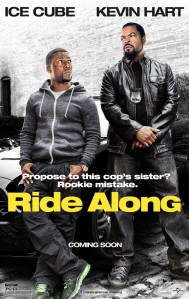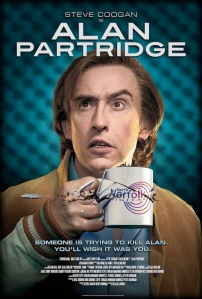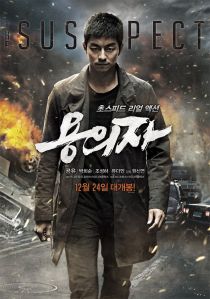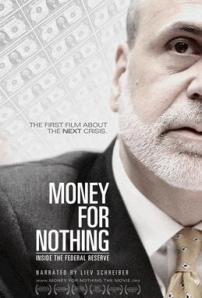Archive
CrowdFUNding: Jamie Tiernay’s Kenny vs. Spenny: On The Road
By: Addison Wylie
It’s no competition that Kenny vs. Spenny – whether you like it or not – has become a staple in Canadian pop culture.
Kenny Hotz and Spencer Rice’s reality television show featured the buddies going toe-to-toe with each other in various matches such as Who Can Win a Ten Mile Race and Who Can Stay in a Haunted House the Longest. However, as the competitions became increasingly irreverent and Hotz’s strategies more torturous to his mensch sidekick, the pair’s cult following grew as stakes got riskier with episodes such as Who Can Drink More Beer and Who Can Get Further With The Other Guy’s Mom. It was a classic case of Schadenfreude.
The show’s been off the air for over three years, and the men have spun off to do their own side projects; leaving Kenny vs. Spenny to settle.
The high demand of a comeback may be what started the inception of an on-the-road reunion. Hotz and Rice are teaming up to hit various parts of Canada and hold Q&As, screen segments from the show, and hand out autographs.
Jamie Tiernay, who worked on Kenny vs. Spenny as a crew member on Kenny’s side of the show, has started a Kickstarter campaign to accumulate funds to make a documentary about the tour.
Learn more below:
The Kenny vs. Spenny On The Road Tour Documentary Kickstarter Campaign is about documenting these two cult legends on their KVS tour across Canada.
Having worked with Kenny and Spenny for over 10 years I’ve convinced them to give me unrestricted access to the tour, themselves and the final cut! I’m going to be poking, prodding, manipulating and uncovering shit you couldn’t even imagine in your wildest wet KVS dreams. A road trip tour friendship extravaganza with dick jokes, fart jokes, drunken nights, insane fans, hot fans, dumb fans and shit that’ll make you pee your pants.
With this $46,000 campaign goal we’ll be able to shoot the whole west coast tour, edit and deliver a pretty kick ass film BUT there’s more tour locations and dates to come this year. So if we PASS OUR GOAL it’ll let us shoot more tours, more insanity and give more editing time to make this the most insane Kenny vs. Spenny documentary film ever!
Visit Jamie Tiernay’s Kickstarter page for more details.
My Two Cents:
Tiernay’s documentary sounds and looks promising, but $46,000 sounds like an inflated random number. However, I trust Tiernay, who obviously has the best intentions for his film and clearly knows how to handle these types of projects. After all, equipment rentals, transportation, and accommodations do add up rather quickly.
I hope the doc doesn’t take on usual road movie and concert film tropes these projects tend to helplessly accept (see: Vince Vaughn’s Wild West Comedy Show: 30 Days & 30 Nights – Hollywood to the Heartland and any live event featuring a member of the Jackass crew). Tiernay’s brief video preview featured enough farting around to make me weary.
But, Tiernay also appears to be focused on the love/hate friendship between Hotz and Rice. As a possible investor, this is a hopeful opportunity that could potentially propel the film in a surprising direction. This could shed more of a natural light onto these two performers.
I wish Jamie Tiernay luck with his upcoming film. It should, at the very least, act as that proper fix for Kenny vs. Spenny diehards.
**********
All italicized statements regarding Kenny vs. Spenny: On The Road are provided from their respected crowdfunding sources. Wylie Writes is not responsible for funds attached to these productions and we do not hold any accountability.
This project is that of the filmmaker’s. Use your own discretion.
Ride Along
Here’s the thing. I’m not mad at Ride Along. I’m not even frustrated with Tim Story’s buddy cop comedy. I’m not miffed, put off, or even slightly perturbed with it. I’m just kind of numb. Barely laughing in a comedy will do that to a person.
I’m writing this review moments after watching the thing because I’m worried I’ll start forgetting portions of it. This vehicle for Ice Cube and Kevin Hart is slowly dissipating from my head and into thin air.
Ride Along is harmless, but it also doesn’t meet its comedic mission statement.
Story’s film came close to making me heartily chuckle. I mildly snickered before the jokes were needlessly stretched by Hart’s incessant motor mouth and Cube’s raised brow.
Hart didn’t amaze me with his stand-up comedy in last year’s Let Me Explain (which Story co-directed), but I think he’s a performer who works better with another person on screen. He appears to be more self-assured with his deliveries when paired with someone to bounce zingers on and off of – nothing wrong with that at all. He just needs stronger material.
My light giggles happened when Hart’s do-gooder character, James, was thrown into a situation where he’s left to flounder. Like Hart has shown in his stage routine though, he doesn’t know when to stick his landing and wrap up the tomfoolery. Story, who’s supposed to know this comedic timing even more, lets Hart ramble until the script calls for an interruption.
Cube usually knows how to play a good straight man, and he continues to prove this in Ride Along. In the film, he plays a protective older brother to James’ girlfriend and is willing to test James to see if he’s “man” enough to be welcomed to the family. Cube, who has shown recently that he loves playing these amusing intimidators, is able to hold his own next to Hart’s frantic personality, and he’s able to competently keep the scene on target despite Hart swinging on tangents.
What cripples Ride Along is its formulaic script and Tim Story’s uncaring attitude. Greg Coolidge, Jason Mantzoukas, Phil Hay, and Matt Manfredi (that’s right, four writers!) provide the skimpy set-ups and then rely on their leads to jumpstart the comedy that’s supposed to ensue. This system may please those who are attending Ride Along to see Hart “have at it”, but the situations don’t provide a heck of a lot of groundwork for these charismatic actors to spring off of.
Cube, who is also attached as one of the film’s producers, looks as if he’s always waiting for more in a scene. As a producer, you would think he’d take this opportunity to bring the writers and Story aside to figure out ways to punch up the material.
Story doesn’t exactly have a great directorial track record when it comes to action flicks (Fantastic 4: Rise of the Silver Surfer, Taxi). With Ride Along, Story doesn’t add any originality to shoot-outs or car chases, and he doesn’t elevate the quality above any miscellaneous early-2000’s action/comedy starring Martin Lawrence.
There’s not a whole lot going for Ride Along in the realm of booming action or side-splitting comedy. All it has are two leading men trying to do everything they can to make this fluff into something noteworthy. But, when the lifeless odds are stacked as conventionally as they are against Hart and Cube, I’m surprised the actors didn’t surrender altogether.
Alan Partridge
North Americans have Will Ferrel’s Ron Burgundy, an on-camera anchorman who’s self-centred arrogance has him chewing down on his own foot often. In Europe, the Brits have Steve Coogan’s Alan Partridge. Partridge is an egotistical radio personality obsessed with a celebrity image and a winning smile.
Where Burgundy can read on screen as a pompous jerk with a heart of gold steeped in spoof misogyny, Partridge is more endearing. He always finds a way to slip into the spotlight, and try to have others sympathize with him or view him as an inspirational icon. However, he’s just as easily flustered and frustrated when he isn’t included.
Steve Coogan’s amusing character takes a step away from real life airwaves and his UK Television show I’m Alan Partridge to star in his first leading vehicle self-entitled Alan Partridge. The film is better known as Alan Partridge: Alpha Papa across the pond, but it’s a title that may have had others scratching their head over its otherwise silly meaning.
That adjustment is what’s going to make Alan Partridge’s overseas success interesting to observe. I think it helps outsiders taking a chance on the film to know a little bit about Partridge before paying for a ticket. His fumbled muttering, and his self-absorbed attitude may have the general North American movie going public growing irritated. However, if they have that initial information or can quickly jive with the lead doofus, they may have themselves as good a time as us fans.
Personally, I found Alan Partridge to be a good comedy that met the goals it set out to achieve. Director Declan Lowney manages to do what most SNL flicks have difficulty doing – taking a sketch character and having him carry a film all the way until the end. It also helps that Coogan is still playing the cocky host splendidly.
Alan Partridge plays out as a movie Mike Myers would’ve jumped at the chance to star in. I wouldn’t call Lowney’s film a laugh-out-loud riot as Myers’ past comedies have been (pre-Love Guru, mind you), but there’s a consistent flow of titters and chuckles that will have you pleased with most of the material. Although, a scene featuring Alan getting caught with his trousers down will definitely shock you into hysterics.
The story of a disgruntled, newly fired radio personality taking the station and its employees hostage doesn’t feel rote, as does the decision to make Coogan the hero despite the role’s narcissism. Partridge, being the unctuous goofball he is, manages to find fame in dire circumstances. He completely understands the danger of the takeover, but is strangely complimented when he’s chosen as a messenger for the police and a co-host for a radio show during the malicious siege.
Lowney’s modest comedy will satisfy the Alan Partridge fan base as well as fans of Coogan’s dry wit. The main question, however, still stands: how the hell is this going to perform outside the UK?
I won’t be surprised if Alan Partridge doesn’t drum up new anticipation during its North American theatrical release, but I won’t be disappointed if this type of movie finds cult life on VOD.
The Suspect
You can’t say The Suspect was mismarketed. All that spectacular stunt work that’s flashed in the film’s trailer is there, and it’s still enthralling in context. What the trailer doesn’t capture is how overblown Won Shin-yun’s film is. Maybe that’s for the better since the lethargic narrative is a major turnoff.
First, the film’s key strength: Shin-yun knows how to map out an action sequence. There are more than enough car chases and crashes in The Suspect to get anyone’s adrenaline pumping. The pursuits are no where near as compelling as the ones movie goers will see soon in Need for Speed, but the chases in The Suspect wet our whistle well. Same goes for the hand-to-hand combat and the gunplay.
My only suggestion for Shin-yun is he shouldn’t feel the need to present his work as anymore generic as clichéd American action fests in order to capture some sort of recognizable excitement. The camera work in The Suspect is either too closed in, shaking around like crazy, or both – which causes some of the fine choreography to be lost in translation. The sloppily choppy editing is also to blame.
There are way too many add-ons set on driving up the film’s intensity. Shin-yun is trying too hard to convince the audience what they’re watching is impressive and energetic. That said, Shin-yun could possibly be shovelling on more of these contrivances to cover up how dull Im Sang-hoon’s revengeful script plays on screen.
Sang-hoon has a very hard time adding onto his characters or the nature of getting even. Instead of building off of his own material, he plunks a lot of “stuff” on top of unfolding events and the emotional characters – none of which are interesting or thrillingly intriguing. He attempts to add twists and new motives, but inverts his characters in a way that make each person on screen become more complicated than they need to be.
The Suspect lacks confidence. The film has the appearance of a movie that knows how baggy it’s getting, and is constantly vying to win back its audience while trying to make ends meet with its own story.
The Suspect does have the look and feel of a smart thriller. As I often drifted into a dazed state, I found myself wondering what a Bourne endeavour would look like through Won Shin-yun’s filmmaking vision. In time, I think he’ll follow the same steps as Fast and the Furious filmmaker Justin Lin and grow to have what it takes to direct a franchise.
Unfortunately with The Suspect, Shin-yun finds himself spinning a number of plates. It’s neither enjoyable for him nor his spirited audience.
Human Rights Watch Film Festival 2014: Saving Face
By: Addison Wylie
The Human Rights Watch Film Festival has made me exhale an astonished “wow” twice now. That’s a compliment I haven’t admitted to in a while. It’s absolutely true in the case of Daniel Junge and Sharmeen Obaid-Chinoy’s harrowing doc Saving Face.
The mighty film, which deservedly won 2012’s ‘Best Documentary Short’ Oscar, shows audiences how disturbingly frequent and heartbreakingly affective acid crimes are. Every year, numerous Pakistani women are dosed with different forms of acidic attacks. The victims are left wondering what they did to deserve such torture and public humiliation.
Impressively, Junge and Obaid-Chinoy interview the alleged attackers – most of which are the husbands. They give emotionless stories claiming they had nothing to do with the burns, and that they’ve been wrongfully accused. The shiftiness in their testimonials as well as their unsupported proof doesn’t hold water – it’s blatant to see that. The filmmaking duo don’t have an agenda to make all Pakistani men look like monsters. They simply ask questions and let their cameras roll. What they capture are sit downs with these apathetic, terrible contributors to lifelong injury.
The act of acid crimes gets lots of attention from those who want to bring justice. A Londoner plastic surgeon, Dr. Mohammad Jawad, flies to Pakistan to survey the pandemic and offer his assistance to reconstruct facial features. We see in every instance that he’s on screen how he tries to maintain his composure while his feelings of sadness and frustration seep out.
For a film that clocks in at under an hour (Saving Face is 52 minutes), the filmmakers pack a lot of development into the film. Junge and Obaid-Chinoy select individual subjects and open their lives up to us. The women, who embrace the filmmakers’ affection, show us what their living conditions are, take movie goers to the original spot where they were attacked, and explain personal barrenness. Saving Face gives audiences a very intimate and utmost honest view behind the veils and burqas without anything feeling too intrusive.
Because these victims are worried that a similar attack will happen in the near future, audiences are also shown other resources where these women can seek protection. We get an unbarred look at ASF – the Acid Survivors Foundation – and the kind saints who seek a change regarding the consequences the initiators face post-crime.
Saving Face is a powerful, well made and competently justified piece of work. The doc may seem quick, but nothing is ever cut too short. It has an impact in both its emotional connection and its respectful representation that beefier films would be jealous of. Just “wow”.
***********
Catch Saving Face at Toronto’s Human Rights Watch Film Festival on Sunday, March 2 at 3:30 pm at the TIFF Bell Lightbox.
Solo Speaks: A One-On-One with Annie Clark
By: Addison Wylie
After being featured at Toronto After Dark, the indie Canadian thriller named Solo is making a more public appearance with a theatrical run at Toronto’s Carlton Cinema.
Carlton Cinema is a very appropriate venue seeing as the theatre and the film both share a level of independence. Carlton Cinema is a quaint theatre that feels as if you step into another world of movie watching, and Solo’s lead is left in her own world to try surviving camp initiation.
Solo serves as a debut for writer/director Isaac Cravit, marking the flick as his first feature length film. The spooky movie is also actress Annie Clark’s first foray into theatrical films. It’s a big move for Clark who is often on screen by herself and having to support the eeriness Cravit has materialized.
I wasn’t too hot on Solo as a whole. It started off strong, and progressively meandered its way into a final product that lacks punch or chills. However, Clark does a commendable job at holding her own. She turns in a promising performance that makes the audience eager to see what else she’ll do with her budding career.
Wylie Writes correspondant Sky Wylie sat down one-on-one with Clark to talk shop about Solo. The two also discuss Clark’s departure from Degrassi: The Next Generation, how a real life camp experience inspired her hopes of becoming an actress, and whether she sees a future for Isaac Cravit directing tense fare.
Listen to the free-form interview here:
**********
Solo is now playing at Toronto’s Carlton Cinema. Click here for showtimes!
Read my review here!
Do You Tweet? Follow These Tweeple:
Solo: @SoloTheMovie
Annie Clark: @AnnieJClark
Sky Wylie: @SkyBaby5
Addison Wylie: @AddisonWylie
Solo
Solo starts out on an “A” game, but ends up finishing with a generous “C” grade.
Isaac Cravit’s independent thriller is a straight-up campfire story – and, the filmmaker knows it. Gillian (played by former Degrassi: The Next Generation co-star Annie Clark) needs to prove herself to be a capable camp counsellor in order to obtain a summer job. The newbie needs to pull a “solo”, a two-night experience on a secluded island that will test her survival skills.
Cravit, directing and writing his first feature film, is having a lot of fun playing with the conventions of a campfire horror. The filmmaker even has fellow councillors telling Gillian rumours of haunted activity that took place on the island before she embarks on her trip.
These moments don’t feel like Cravit is pushing too hard for the audience to recognize what the film is trying to be and he sticks his landing well with these scenes of eerie dialogue.
When Gillian arrives at the island and is forced to investigate mysteries in the woods at night, Cravit nails the creepiness. As the camera slowly moves around a freaked out Clark, we can’t help but get sweaty palms as we feel ourselves growing more anxious. What’s better is that there aren’t too many of these moments, making these quiet pressure cookers enunciate strongly when they happen.
Cravit is also having a ball throwing red herrings at his audience, including possible antagonists that may have more to do with the island’s history than we realize.
Solo reveals more, including what’s overlooking Gillian. The routes the film travels on is all a matter of subjectivity. I watched Solo with my wife, who enjoyed where Cravit took his scary movie. I, on the other hand, thought these decisions made the film less effectively stimulating and increasingly mundane.
Without spoiling the main course, Cravit’s screenplay makes the right choice to make delirium the main evil in Solo. The problem is – for me, at least – he chooses the wrong type of crazy. Solo would’ve been better off as something more psychological than being so literal.
Solo is typical enough to get by. Some gory effects towards the end are appreciated and certainly help matters tonal wise. But, part of the joy of watching these smaller scale horrors/thrillers is finding steady specialties that make movie goers gush to others about the film – resulting in consecutive views. I just didn’t get that with Solo.
Pompeii
By definition, Paul W.S. Anderson is a filmmaker. In my eyes, he’s not a very good filmmaker, but he’s been able to create brainless successes.
His latest blunder Pompeii is by definition “mindless entertainment”. The film follows similar conventions that were used in his Resident Evil adaptations, and he crosses his fingers hoping people will eat it up all the same.
It’s expected people will walk out of Pompeii passively shrugging off the film as “dumb, but passable fare”, and be perfectly indifferent with it. For some reason, knowing that something is going to be “dumb, but passable fare” before going into the movie allows Anderson to do just that and not let down movie goers with those low expectations. It’s how he was able to get away scot-free with most of his action flicks, and why people consider his work “critic proof”.
As I stated in my steaming review of Resident Evil: Retribution, audiences deserve better – even if it is just surface-level escapism. Pompeii is another example of this filmmaker shafting movie goers in every single way, along with an added PG-13 rating restraining Anderson from showing any over-the-top violence.
The movie takes place in 79 A.D. preceding a monumental catastrophe. It’s to no surprise that Anderson’s drowsy directing leads to borrowing beats from more enthralling epics such as Gladiator, Titanic, and miscellaneous disaster movies. It never feels original because of these blatant rip-offs of other popular films. Even so, Anderson can never sell us on his second-hand saga because of how little effort everyone involved has put forth.
Game of Thrones’ Kit Harington takes the role of the film’s brawny protagonist, Milo. He fills out the part physically, but hasn’t done any further work to make this character into anything more than a cardboard standee. This is merely a starring role to test the cinematic waters of whether Harington convinces audiences nationwide that he’s a tough guy on a bigger screen. He may look the part, but with due time, he’ll realize sombre gazes and rippling abs don’t necessarily help develop a character.
The rest of the cast follows along similarly. They’ve been cast based on looks alone. The film’s logic behind its casting is that if you can look attractive while touting a wiry beard or filthy volcanic schmutz on your face, you can be a movie star.
The rest of Pompeii’s production is comparably unsubtle and shoddy. Whether it’s caking make-up onto an increasingly scantily clad Emily Browning as Milo’s love interest, or showing Keifer Sutherland’s credit as he enters the scene articulating a ridiculous accent with overacting theatrics. We’re constantly reminded that this is one big, loud, clumsy movie.
For a film carrying historical content, I at least expected Anderson to impress me with period detail. It appears everyone is costumed in proper garb, but Anderson flatly shot his film as if he’s wanting to emphasize that everything’s been shot indoors on a sound stage. There’s no movie magic here. Just a bunch of clanging effects mounted on top of artificial acting.
It goes to show paying audiences that no one behind Pompeii cared to make a convincing product. The general attitude was apathetic and as static as those inevitable post-screening shrugs.
It’s as if before a day of shooting, Anderson grouped the cast and crew together for a powerpoint rundown of “how to make a by-the-numbers money maker”. It’s a list of steps dancing around the fact that the end product will also be defunct of any legitimacy amongst the reactions on screen and in the audience. But, the filmmaker would remind his team that everyone would collect a hefty paycheque once the turkey was in the can – this would cause a cheerful uproar.
The steps on Anderson’s play-by-play include pausing the film to spill countless pages of spoken exposition, drawn out buddying between Milo and his oppressive cell mate Atticus (played by Adewale Akinnuoye-Agbaje), and silly romance with forced chemistry in tow between Browning and Harington. Plus, you can’t forget those choppy fight sequences that have been hacked to death by autopiloted editors, and their collection of odd pandering zooms to highlight intensity.
Of course, if you’re going to make a big blockbuster involving lots of flying debris from a natural disaster, it has to be in 3D. If Pompeii’s 3D is what counts as today’s standard for the groundbreaking technology, I’m in the wrong business. Apparently, in the case of Pompeii, all you have to do is make a few ashes float towards the viewer and have credits punch out. With an entire two thirds dedicated to droning dialogue in darkly lit settings, it’s the laziest and most unnecessary use of the technology since Thor.
Pompeii is the junk food everyone knows is loaded with carbs and sugar, but they give in because they’re jonesing for the occasional juicy treat. Trust me, there are better ways for those movie goers to indulge in mindless entertainment. If they’re patient, they can hold out for that movie that understands the trick to trashy thrills. Eager audiences shouldn’t feel the need to count on Paul W.S. Anderson’s stale bargain bin tidbits to get their fill.
AKP: Job 27
When the only bad thing about your feature film debut is its marble-mouthed title, it’s a sign that your ambitious film is close to being sublime.
When you get past that weak title, AKP: Job 27 is a really good time at the movies. It treads trodden ground by being centred around a private hitman on a mission in unfamiliar territory (the territory being Toronto), but its Michael L. Suan’s vision of the story that brings it into a league of its own.
Suan takes a leap of faith by making AKP: Job 27 a modern day silent film. The closest the film gets to using dialogue are screams when our shadowy lead is on the clock and firing off his gun. As the writer/director, Suan gives himself the task of justifying why the film is void of dialogue – he does a good job with doing so.
Very rarely does it feel like the silence is unmotivated. Early group confrontations make us wonder why these people aren’t breaking the ice. Same goes for quick questionings when our no-named hitman is looking to be rightfully directed.
That said, Suan actually covers himself quite well. Music accompanies the feature ranging from instrumental tracks to classics to contemporary remixes. When our lead is asking questions, we see his mouth move but club music drowns him out. This shows us that Suan isn’t senselessly feeding his audience. He knows there will be skeptics out there, and he confidently wants them to relax.
Aside from the tastefully and artistically portrayed violence, the hitman is constantly haunted by a lost love that he was responsible for. He tries to fill in the personal gap, but is always reminded why those prior feelings are irreplaceable. He does start falling for a wayward prostitute, who strikes an uncanny resemblance to his departed beloved.
That’s Roxanne Prentice playing both the roles of the unspoken love and the prostitute. Prentice does a fantastic job at balancing both key parts, and has an array of expressions to flawlessly communicate to the audience. She’s a natural in the silent film genre.
Tyce Philip Phangsoa plays the hitman with preserved heartbreak while also maintaining focus on his acquitted tasks. It’s a performance that would be daunting to any actor. They have to convey a softer side while keeping their potent intimidation at the forefront. Phangsoa does so, masterfully.
Michael L. Suan’s flick starts off in Japan and fluently transitions to the Canadian environment. He doesn’t outdo himself with trying to make iconic Toronto landmarks evident, but is wanting to show that this crime underworld can be easily hidden and can exist anywhere. Movie goers will often forget that AKP: Job 27 takes place primarily in Toronto – that’s a good thing.
The film briefly gets carried away with itself. For example, the film’s look is stunning, but every so often the inky mood will make the visuals too dim. And, Suan (who is also the editor, along with Biko Franklin) could’ve trimmed some sequences. There’s ten minutes scattered in AKP: Job 27 that could’ve been easily shaven. Luckily, these instances always find a way to move onto stronger material.
I hope AKP: Job 27 isn’t the only project we’ll get to see from this filmmaking newcomer. Suan shows that he’s perfectly capable of representing hard-edged fortitude and tantalizing sexiness without overvaluing his talents. To make a silent film like AKP: Job 27 takes courage and stylistic spunk. Suan has succeeded with these attributes in – what’s sure to be – one of the greatest independent films you’ll see this year.
Money for Nothing: Inside the Federal Reserve
Personally, my knowledge of the Federal Reserve goes about as deep as a mall fountain collecting pennies and dimes. Naturally, Jim Bruce’s documentary Money for Nothing: Inside the Federal Reserve should be the perfect vehicle to educate people like me who need a bit more information about its history and the possibly bleak future it has ahead of it.
Jim Bruce seems like the right filmmaker for the job seeing that he’s previously worked on The King of Kong: A Fistful of Quarters, a fantastic documentary that includes everyone in the audience. Money for Nothing marks his directorial debut.
As much as Bruce has tried to make the content in Money for Nothing accessible through visual examples and interviews with financial intellectuals, he loses his audience too many times. During the first third, the filmmaker slows down his doc so everyone can catch up. However, he forgets who he’s pitching his film towards and gradually moves faster – leaving confused movie goers in the dust once again.
At one point, Bruce gets so far ahead of himself, that it’s almost as if he ignores the fact that his audience’s interest is dwindling. He shrugs his shoulders and takes off full speed ahead. Meanwhile, I’m trying to follow as best as possible, but sense a disconnect between myself and the content.
On that level, the doc fails. The main purpose of a documentary is to educate and inform. When the documentarian doesn’t show signs of compassion and gives up hope on rustier movie goers, the project becomes one-sided as it talks directly to those who have a clearer understanding of the topics at hand.
Even though I realized this doc may not be for me entering into Bruce’s film, I was an open book when I started watching. I’ve gone into documentaries before knowing very little about the topic at hand, and have finished those films feeling enlightened. With Money for Nothing, I feel embarrassed to admit I was led astray many times. Instead of filling my mind with new thoughts and opinions, it just reminded me about how little I know about this financial world, which in turn makes me feel glum and dumb. I can imagine other movie goers who are like me will feel the same.
What Jim Bruce’s doc has going for it though is its clean-cut presentation. Interviews have been shot competently, animated segments and the usage of different clips to generate comparisons or allegories are much appreciated and add a fresh change of pace, and Liev Schreiber’s narration is fitting and doesn’t draw attention to the celebrity.
At the end of the day, what matters most is the information to which the doc is built on. Bruce may have it locked down, but he unwieldy delivers it to his spectators.
For those viewers who are bonkers for dollar bills, you may find yourself enjoying what Money for Nothing has to offer – though most of this may be old news to you. Everyone else, however, may be finding themselves drawing nothing from the money they spent on admission.










